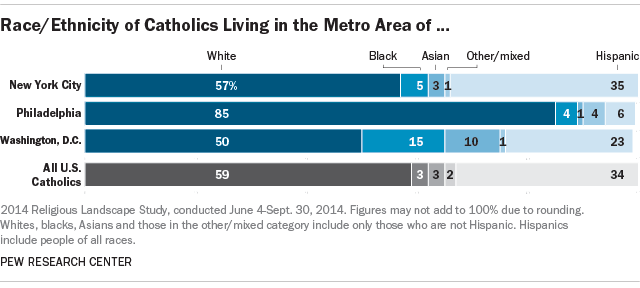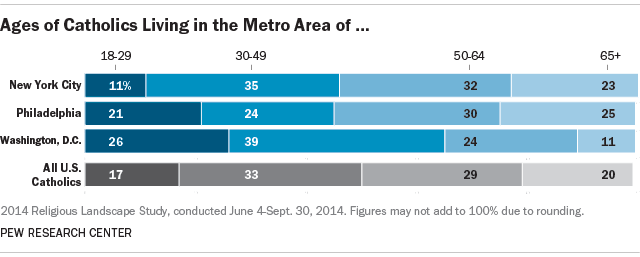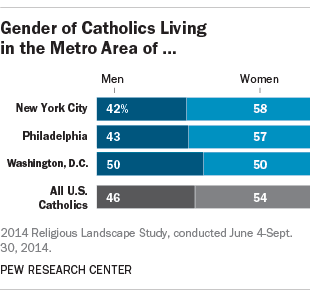On his first papal trip to the U.S., Pope Francis will visit three Northeastern cities that are within a few hundred miles of each other. But while New York City, Philadelphia and Washington, D.C., may be geographically close, their Catholic populations look different from one another in several ways, according to data from the 2014 Religious Landscape Study.
For instance, 85% of Catholics in the Philadelphia metropolitan area are non-Hispanic whites. Whites, however, make up smaller shares of the Catholic populations in New York (57%) and Washington (50%).
From a racial and ethnic perspective, Catholics in the NYC metro area look very similar to U.S. Catholics overall, including about a third who are Hispanic. Fewer D.C.-area Catholics are Hispanic (23%), while more in the capital are black (15%) or Asian (10%) compared with the country overall.

In addition, Washington Catholics are significantly younger than Catholics in New York and the country as a whole. Roughly a quarter of D.C.-area Catholic adults are under age 30 (26%), compared with just 17% of U.S. Catholics overall who are in this age group – and only 11% in New York City. At the same time, just 11% of Washington, D.C., Catholics are 65 or older, compared with 20% of all U.S. Catholics and 23% and 25% of Catholics in New York and Philadelphia, respectively.

 In general, there are more women (54%) than men (46%) in the American Catholic population. This trend holds true in New York, where 58% of Catholics are women. In Philadelphia, 57% of Catholic adults are women and 43% are men. And in Washington, D.C., the gender split is an even 50%-50%.
In general, there are more women (54%) than men (46%) in the American Catholic population. This trend holds true in New York, where 58% of Catholics are women. In Philadelphia, 57% of Catholic adults are women and 43% are men. And in Washington, D.C., the gender split is an even 50%-50%.
Catholics in Philadelphia area are more highly educated than U.S. Catholics overall. While nearly half of U.S. Catholics (46%) have no more than a high school education, only about a quarter of Philadelphia’s Catholics (26%) are in that category. And Philadelphia Catholics are twice as likely as all U.S. Catholics to have a postgraduate degree (20% vs. 10%). New York-area Catholics, meanwhile, have roughly the same levels of education as all U.S. Catholics.

Catholics in these three metro areas all tend to have at least somewhat higher household incomes than do U.S. Catholics overall, perhaps reflecting the higher cost of living in these areas. Catholics in the D.C. area have especially high incomes: 29% of Washington Catholics report household incomes of $100,000 per year or more, compared with 19% of all U.S. Catholics who are in this income bracket.

One demographic measure where the three metro areas are similar is the marital status of their Catholic populations. Nearly or roughly half of Catholic adults in New York (50%), Philadelphia (45%) and Washington, D.C., (45%) are married, similar to U.S. Catholics overall (52%). About one-in-ten Catholics in each area (and in the country as a whole) report that they are currently living with a romantic partner outside of marriage.




